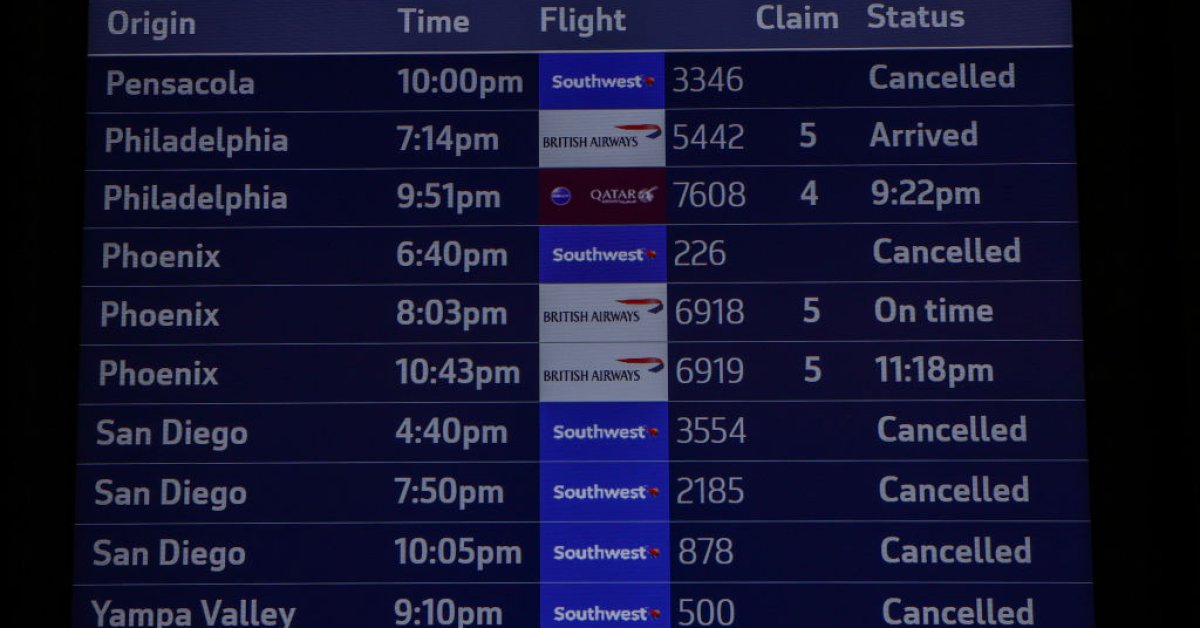|
Getting your Trinity Audio player ready...
|
Southwest Airlines expects the flight chaos caused by the massive winter storm that battered the US to continue for at least another few days as the government questioned whether the airline is complying with its customer service plan.
“In all likelihood we’ll have another tough day tomorrow as we work our way out of this,” Chief Executive Officer Bob Jordan said in an interview with the Wall Street Journal on Monday evening. “This is the largest scale event that I’ve ever seen.”
Southwest plans to operate just over one-third of its typical schedule in the coming days to allow crews to get into the right positions, Jordan said, adding that the reduced schedule could be extended.
Dallas-based Southwest canceled almost 3,000 flights on Monday and had hundreds of others run late, disrupting more than 80% of its schedule as operational woes mushroomed in the wake of the storm.
The trips wiped off the books meant that Southwest was responsible for almost three-fourths of cancellations in the US. That made the biggest discount carrier an unhappy outlier in the US industry, where recovery was the watchword after a holiday weekend of travel tie-ups.
Later on Monday, the US Department of Transportation said it was concerned by Southwest’s “unacceptable” rate of cancellations and delays as well as reports of a lack of prompt customer service.
The DOT said it will examine whether the cancellations were controllable and if the company is complying with its customer service plan.
Southwest did apologize for the disruptions, saying that although the airline was fully staffed for the holiday, 23 out of its 25 top airports were affected by the storm.
“With consecutive days of extreme winter weather across our network behind us, continuing challenges are impacting our customers and employees in a significant way that is unacceptable,” the airline said in a statement. The storm “forced daily changes to our flight schedule at a volume and magnitude that still has the tools our teams use to recover the airline operating at capacity.”
Travelers took to Twitter to vent about the turmoil, whose arrival in the midst of a busy holiday punctuated a dismal year for the US airline industry. With Southwest’s stock down 16% this year through Dec. 23, the stock is headed toward a third straight annual decline, the worst such run since a similar stretch that ended in 2008.
On Tuesday, the shares declined 3.6% in U.S. pre-market trading.
The storm over the weekend affected a wide swath of the US and Canada, with record snow totals in the Midwest and Buffalo, New York — the area hardest hit by the storm where as many as 27 people have been reported dead.
Getting Worse
Southwest canceled 67% of its flights Monday, according to flight tracker FlightAware, even more than the 42% of flights abandoned Sunday. By contrast, Delta Air Lines Inc. — which dumped 21% of flights on Sunday — had to drop only 8% of its flights Monday. FlightAware said 18% of Southwest’s flights were running late.
Unlike competitors that use a so-called hub-and-spoke system to funnel passengers to large airports, Southwest is focused on point-to-point service, flying the same aircraft — Boeing Co. 737s — on trips that may hopscotch around the US.
Southwest is the biggest carrier serving Buffalo, the hardest-hit urban area in the storm’s path and the focus of continued foul weather on Monday. While that accounted for part of Monday’s upheaval, FlightAware data showed struggles in cities where Southwest has major operations, including Dallas, Phoenix and Las Vegas.
Entitled to Refunds
Ryan Green, Southwest’s chief commercial officer, told the Wall Street Journal that the airline is taking steps like covering customers’ reasonable travel costs — including hotels, rental cars and tickets on other airlines, and will be communicating the process for customers to have expenses reimbursed.
People whose flights have been canceled are entitled to refunds if they opt not to travel, Green was quoted as saying.
The tumult evoked memories of other tie-ups at Southwest and elsewhere. Southwest blamed a worker shortage, an air-traffic control interruption and bad weather for a four-day disruption that erased 3,100 flights in late 2021. In 2007, JetBlue Airways Corp. cut 1,102 flights over six days — almost a third of its schedule — after a Valentine’s Day ice storm.
More Must-Reads From TIME



